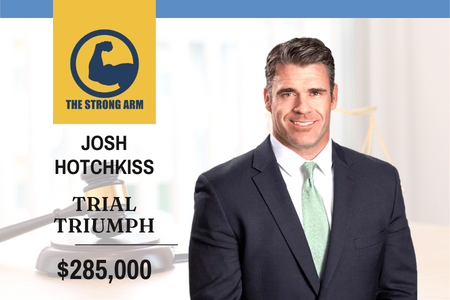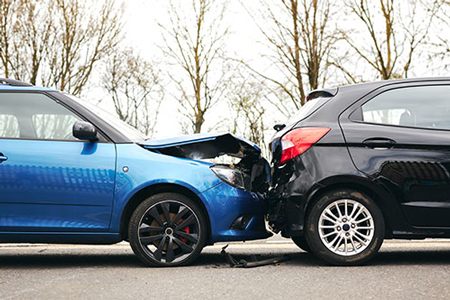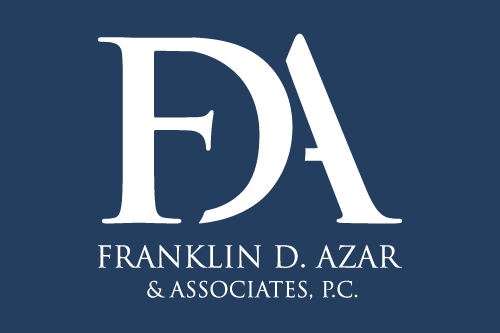AZAR FIRM WINS BIG FOR INJURED CYCLIST
Two years ago a bike-car collision in Aurora left a young former Marine with agonizing injuries, hundreds of thousands of dollars in medical bills, and a complicated legal case in which the other side was disputing who was at fault.
Many personal injury law firms would have refused to take such a case or would have urged the client to take a quick settlement. But this client hired the law firm of Franklin D. Azar & Associates, which wasn’t shy about taking his case to trial. A few weeks ago, an Arapahoe County jury awarded the man more than $240,000, untangling a formidable series of claims and counter-claims.
“I think it’s representative of the kind of firm we are,” says Azar attorney Josh Hotchkiss, who led the plaintiff’s legal team. “We take on difficult cases, and we’re not afraid to use our resources to help our client.”
In June 2020 the client was on a three-hour bike ride, training for a triathlon, and thirty minutes from home when the smash-up occurred. He was crossing an intersection at East Iliff Avenue and South Salida Way in Aurora when he was struck by a vehicle turning right. The collision sent him and his bike flying and ruptured rotator cuffs in both shoulders.
Attorneys for the driver of the car denied any liability for the incident. They claimed that the injured cyclist was riding after sunset and that there were visibility issues. They counter-sued for the damage to the defendant’s vehicle. Their best offer of settlement before trial was $25,000, which amounted to roughly a tenth of the Azar client’s medical bills. So the Azar team went to court. They presented evidence that their client was in the crosswalk at the time of the collision, with the same rights as a pedestrian crossing the street, and that there was more than adequate light to see the cyclist, but the defendant failed to do so.
The jury awarded the plaintiff the full amount of his medical bills as well as claims for impairment and pain and suffering. The panel also found him thirty percent liable for the accident. The adjusted award comes to $243,543.74 – more than enough to cover the medical costs and aid the client in his recovery.
Attorney Hotchkiss says his client was “very pleased” with the result. “If you go through something like that with someone, you become very close to him and his family,” Hotchkiss observes. “We were on Cloud Nine for a week.”
WHAT YOU NEED TO KNOW ABOUT REAR-END COLLISIONS
The most common type of traffic accident is also one of the most preventable ones. According to data collected by the National Highway Traffic Safety Administration, nearly a third of all car crashes are rear-end collisions, resulting in thousands of injuries and fatalities each year. In the majority of these wrecks, the lead vehicle was stopped or moving very slowly at the time it was struck from behind by another vehicle.
Even at low speeds, the impact of a rear-end collision can have serious, life-changing consequences. It can lead to a chain reaction of rear-end crashes by other vehicles as well. But many of these incidents could be avoided if drivers would only take more care to protect themselves and others on the road.
WHY SO MANY REAR-END CRASHES?
Many factors can contribute to a rear-end collision, but the most frequent cause is the failure to maintain a safe distance from the lead vehicle — in other words, tailgating. The National Safety Council recommends keeping at least three seconds of reaction time between you and the vehicle ahead, which you can clock by picking some stationary sign or landmark that the vehicle passes and counting how many seconds it takes for your vehicle to reach the same point. (If it’s less than three, you’re following too close.)
The three-second rule may not be sufficient in all situations, but it’s a handy benchmark and keeps you aware of how traffic is moving around you. That’s critical, since other frequent causes of rear-enders include speeding, distracted driving, and bad weather. If you’re not paying enough attention to road conditions and slowdowns ahead, you’re far more likely to end up plowing into a stopped vehicle.
WHO IS AT FAULT IN A REAR END COLLISION?
In almost all rear-end crashes, the party that crashed into another vehicle from behind is going to be considered responsible for the crash. That person might claim that the lead vehicle braked too suddenly for the crash to be avoided, but most of the time it’s likely that the second driver is going to be found to have followed too closely. There are exceptions, of course; if the lead vehicle’s brake lights don’t work, for example, or someone cut recklessly in front of you, or icy road conditions contributed to the crash, you might have some defense. But keeping a safe distance is every driver’s responsibility.
WHAT HAPPENS IF YOU ARE REAR-ENDED?
Rear-end crashes are a leading cause of whiplash injuries, which can include neck and head pain, stiffness, headaches, dizziness, ringing in the ears, pain in the jaws, back, shoulders or arms, or a general sense of tenderness, soreness and fatigue. In many cases, the pain may not be apparent in the immediate aftermath of the accident and may only manifest many hours later. The impact can also result in herniation, soft tissue damage, fractures, soft tissue damage, and other injuries.
HOW CAN REAR-END CRASHES BE AVOIDED?
It’s impossible to control the behavior of other drivers, of course, but there are steps you can take to try to protect yourself from being rear-ended. First, make sure your brake lights and brakes are working properly. Signal your intentions clearly to drivers behind you and avoid stopping abruptly whenever possible. If you detect someone who’s tailgating, speeding, driving aggressively, or being inattentive behind you, don’t engage in any provoking behavior, such as braking frequently to call attention to the tailgating. Instead, pull over when it’s safe to do so, let them pass, and keep your distance.
WHAT IS “PAIN AND SUFFERING” IN AN ACCIDENT CASE?
It’s not difficult to put a price tag on some of the more obvious losses that a person experiences as the result of a car wreck. There are hard numbers to be found in the hospital bills, the trips to the doctor or the physical therapist, the car repair bills, and so on.
But not all of the damages from a collision are so easy to calculate. Depending on the severity of the injuries, accident victims may be facing a series of long-term challenges on the road to recovery that aren’t easy to quantify. Such damages are considered pain and suffering damages – which, under Colorado law, can be included as part of your claim in a personal injury lawsuit against those responsible for the crash.
WHAT CONSTITUTES A PAIN AND SUFFERING CLAIM?
The more readily calculated damages from a personal injury case, such as medical costs, repair bills and lost wages, are known as economic damages. Pain and suffering claims are considered a form of non-economic damages because they involve trying to put a value on the more intangible, deeply personal kinds of loss stemming from an accident. Those damages may encompass everything from chronic physical pain or disfigurement to shock, emotional suffering, insomnia, psychological illness, the inconvenience and pain associated with time-consuming rehabilitation, and what is known as loss of consortium (loss of the companionship and affection of a spouse) and “loss of enjoyment of life” (which is exactly what it sounds like).
HOW DO YOU PROVE A PAIN AND SUFFERING CLAIM?
Just as with economic damages, plaintiffs are expected to support a pain and suffering claim with documents, testimony, and other evidence. It is important to establish that the accident is the cause of the pain and suffering; typically, the claim might involve various medical records as well as statements from treatment providers, pain management specialists, therapists, counselors, or family members. If the case goes to trial, a jury will consider how the crash has impacted the victim’s quality of life in deciding what damages to award for pain and suffering.
WHY PURSUE A PAIN AND SUFFERING CLAIM?
Some of the fallout of a bad car wreck can’t be measured in simplistic terms. How can you put a price on days or weeks lost to pain and frustration, estrangement from loved ones, the diminishment of your own sense of self-worth? Yet that is what our experienced personal injury attorneys try to do to help make our clients whole again. Seeking damages for pain and suffering can be an important step in the entire recovery process.
The Car Accident Lawyers At FDAZAR
For more than thirty years the attorneys at Franklin D. Azar & Associates have helped thousands of injured people obtain complete and timely compensation for their losses. Our proven track record and expertise have allowed us to grow into the largest personal-injury law firm in Colorado, with offices in Denver, Aurora, Thornton, Fort Collins, Grand Junction, Greenwood Village, Colorado Springs, and Pueblo. If you’ve been injured in a bus, car, truck, or motorcycle accident, you may be entitled to compensation. Please call the car accident attorneys at FDAzar day or night at 720-707-2143, or contact us here for a free consultation and no-obligation evaluation of your case.
Join Frank Azars Monthly Newsletter
"*" indicates required fields




